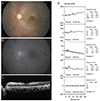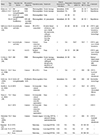1. Hwang G, Woo SJ, Jung C, et al. Intra-arterial thrombolysis for central retinal artery occlusion: two cases report. J Korean Med Sci. 2010; 25:974–979.
2. Park SJ, Choi NK, Seo KH, et al. Nationwide incidence of clinically diagnosed central retinal artery occlusion in Korea, 2008 to 2011. Ophthalmology. 2014; 121:1933–1938.
3. Hazin R, Dixon JA, Bhatti MT. Thrombolytic therapy in central retinal artery occlusion: cutting edge therapy, standard of care therapy, or impractical therapy? Curr Opin Ophthalmol. 2009; 20:210–218.
4. Ashwin PT, Mirza S, Ajithkumar N, Tsaloumas MD. Iatrogenic central retinal artery occlusion during treatment for epistaxis. Br J Ophthalmol. 2007; 91:122–123.
5. Klein ML, Jampol LM, Condon PI, et al. Central retinal artery occlusion without retrobulbar hemorrhage after retrobulbar anesthesia. Am J Ophthalmol. 1982; 93:573–577.
6. Li W, Hu Z, Gao R. Iatrogenic central artery embolism. Yan Ke Xue Bao. 1990; 6:102–104.
7. Park SW, Woo SJ, Park KH, et al. Iatrogenic retinal artery occlusion caused by cosmetic facial filler injections. Am J Ophthalmol. 2012; 154:653–662.e1.
8. Tappeiner C, Garweg JG. Retinal vascular occlusion after vitrectomy with retrobulbar anesthesia-observational case series and survey of literature. Graefes Arch Clin Exp Ophthalmol. 2011; 249:1831–1835.
9. Feibel RM. Current concepts in retrobulbar anesthesia. Surv Ophthalmol. 1985; 30:102–110.
10. Torres RJ, Luchini A, Weis W, et al. Combined central retinal vein and artery occlusion after retrobulbar anesthesia: report of two cases. Arq Bras Oftalmol. 2005; 68:257–261.
11. Giuffre G, Vadala M, Manfre L. Retrobulbar anesthesia complicated by combined central retinal vein and artery occlusion and massive vitreoretinal f ibrosis. Retina. 1995; 15:439–441.
12. Sullivan KL, Brown GC, Forman AR, et al. Retrobulbar anesthesia and retinal vascular obstruction. Ophthalmology. 1983; 90:373–377.
13. Morgan CM, Schatz H, Vine AK, et al. Ocular complications associated with retrobulbar injections. Ophthalmology. 1988; 95:660–665.
14. Mieler WF, Bennett SR, Platt LW, Koenig SB. Localized retinal detachment with combined central retinal artery and vein occlusion after retrobulbar anesthesia. Retina. 1990; 10:278–283.
15. Jacobi PC, Dietlein TS, Jacobi FK. A comparative study of topical vs retrobulbar anesthesia in complicated cataract surgery. Arch Ophthalmol. 2000; 118:1037–1043.
16. Cowley M, Campochiaro PA, Newman SA, Fogle JA. Retinal vascular occlusion without retrobulbar or optic nerve sheath hemorrhage after retrobulbar injection of lidocaine. Ophthalmic Surg. 1988; 19:859–861.
17. Roth SE, Magargal LE, Kimmel AS, et al. Central retinal-artery occlusion in proliferative sickle-cell retinopathy after retrobulbar injection. Ann Ophthalmol. 1988; 20:221–224.
18. Mameletzi E, Pournaras JA, Ambresin A, Nguyen C. Retinal embolisation with localised retinal detachment following retrobulbar anaesthesia. Klin Monbl Augenheilkd. 2008; 225:476–478.
19. Stewart JM. Mechanism of ophthalmic artery occlusion following pars plana vitrectomy. Br J Ophthalmol. 2003; 87:376.
20. Horven I. Ophthalmic artery pressure during retrobulbar anaesthesia. Acta Ophthalmol (Copenh). 1978; 56:574–586.
21. Vinerovsky A, Rath EZ, Rehany U, Rumelt S. Central retinal artery occlusion after peribulbar anesthesia. J Cataract Refract Surg. 2004; 30:913–915.











 PDF
PDF ePub
ePub Citation
Citation Print
Print


 XML Download
XML Download